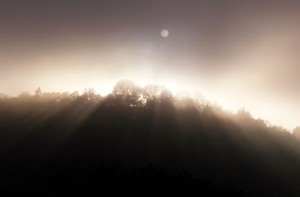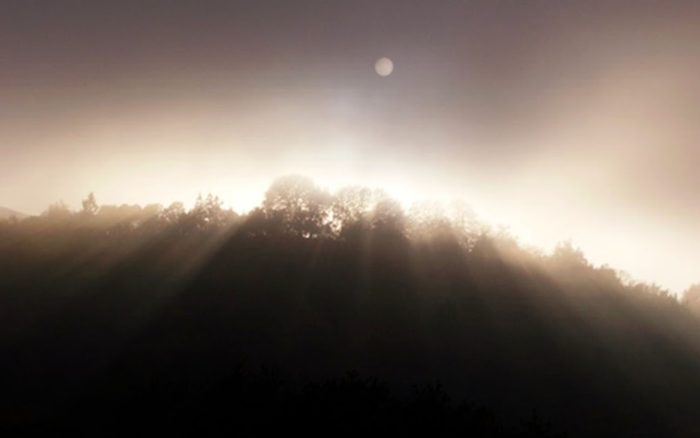 |
| Photo Courtesy of Melissa McLaughlin |
Article by Patricia Damery
Meditation at First Light
You Take My Breath Away
You take my breath away,
of the grand meadow.
A Soul’s Song
A hawk cries, hunting in the forest and patchy clearings surrounding the remote house my writing coterie and I share a weekend each month. There is no television or internet access, and cell phone reception is spotty, so while here we are out of touch with the outside world. Yet paradoxically, we are so much more in touch, too.. A bobcat appears at the forest edge and pads soundlessly by our windows. At night coyotes serenade. Deer crash through the uncleared brush surrounding the house. These sitings and sounds sensitize us not only to the natural world, but to our interior worlds as well. The retreat from most of civilization’s noise makes it possible to apprehend inner space, that space in which creative work happens.
To spend the time here each month is a gift. Even though we may hear chain saws on neighboring properties, or dogs barking, or sometimes the distant din of traffic, nature’s volume is louder.
Jung spoke about the impact on our psyche of the environmental onslaught of noise in a 1957 letter to Professor Oftinger, saying that it not only disturbs concentration but also takes effort to ignore. These efforts result in “a premature depletion of your vital substance.” (1) Jung felt that noise has come to fill a defensive purpose. “Noise protects us from painful reflection, it scatters our anxious dreams, it assures us that we are all in the same boat and creating such a racket that nobody will dare to attack us.” (2)
Jung suggested a darker motive to the unconscious collective acceptance of the level of noise of our modern day world. Overpopulation brings with it the push to depopulate to numbers more in balance, and one way to do this is to unconsciously ignore unbearable fear: of climate change, of corporate takeover, of impending earth changes. “If there were silence, their fear would make people reflect, and there’s no knowing what might then come to consciousness,” Jung wrote. (3)
A disturbing bio-psychological post-World War II German study (Rational Psychology Association, Munich) of the processing of stimuli and emotions of 4000 Germans (4) reports dramatic changes in the population’s sensory abilities over the last 60 years due to overstimulation. At first only smell and taste were impaired. The area of the brain sensitive to taste required sweet to be sweeter; salt to be saltier; sour, sourer. Bitter had to be 15 times as bitter to register. Smells are evaluated differently in those born since 1969. Scents that once were romantic, like the blossoms of a chestnut tree, tend to be repulsive to the younger generation.
In the 1980’s, however, hearing was also being effected. In the 1970’s the average German in the study could distinguish 300,000 sounds, but today only 180,000. Many children never go past 100,000. Whereas 100 decibels used to be the pain threshold, now environmental noise in urban life often exceeds this level. The result is that the brain has begun to accept the louder sounds and to ignore the softer ones. In nature this happens in emergency situations, but now the brain appears to be doing it all the time. (5)
Furthermore, to deal with so much stimulation, the brain appears to have changed some of its internal processing. Before, a stimulus on the way to the optic center would travel through various areas of the brain. Now the stimulus bypasses these and goes straight to the visual center, making it possible to take in information without an emotional reaction or feeling valuation. Information is stored independently, creating what these researchers call, “an enhanced tolerance of dissonance.” This is very different from what we Jungians try to do in holding the opposites. The brain “refuses to bring the contradictory pieces of information into any kind of a relationship with each other.” Enter what these researchers call the “new Unconsciousness.” (6)
Our modern consciousness, localized in the cortex and affording morals and intellect, developed about 10,000 years ago, (7) with Neolithic man, and the advent of agriculture, about the time the Pomo were setting up camp along this property’s creek. Our neurological development has been spawned in places like this. The interaction with the animals, plants, soils, and rocks were an important part of that. We are entrained with the natural rhythms of our world. Nature truly is our mother.
Until now the brain has always adapted to changes in its environment by changing its organization. Now it appears that it may be changing itself. If we do not challenge this process of storing opposing, contradictory information without creating the space for synthesis (periods of relief and quiet where we can integrate what we experience), neurophysiologists suggest that the actual physical structure of the brain will change by the middle of the 21st century. Already they have discovered a new phenomenon: the brain installing a series of new interfaces and new processing programs which can close everything out except what is focused upon without the distraction of emotion or feeling valuation.
This is the ultimate in fragmentation of the psyche: in lieu of the time, space, and quiet to reflect and process our experiences and perceptions, the physical brain becomes ever more one-sided in order to tolerate over stimulation. According to this study, consciousness is becoming ever more restricted.(8) As Jung commented, “If there were silence, their fear would make people reflect…”. If we do not take in our devastating impact on the air, the soils, the plants, animals, and on each other, we lose what ability we have to make informed decisions to restore balance, leaving it up to Mother Nature. That which is human within us and without is at serious risk of survival.
It is with profound grief—and deep pleasure— that, in the pounding silence of dawn, I listen and witness in this almost forgotten of places. Will we remember soon enough that we are only one part of this whole? Will we remember we are all in this together, and that we are inextricably connected to the human and the non-human, our brains’ organization and form, born of the hawk’s cry? All we need is here; its apprehension is the remedy: the awe— of the sun rising above the apple trees, of the bobcat appearing suddenly on the path, of the deer and two spotted fawns eating blackberries twenty feet from the back deck. This is the medicine: the slowing, the quiet surprise, and then, if grace bestows it, a poem, or a soul’s song.
Farming Soul
, a courageous offering that will help to reconnect us to our deeper selves, the often untouched realities of soul, and at the same time ground us in our physical
relationship to self and Mother Earth.
In addition to being the author of Farming Soul, Patricia Damery is an analyst member of the C.G. Jung Institute of San Francisco and practices in Napa, CA. She grew up in the rural Midwest and witnessed the demise of the family farm through the aggressive practices of agribusiness. With her husband Donald, she has farmed biodynamically for ten years. Her chapter, “Shamanic States in Our Lives and in Analytic Practice” appeared in The Sacred Heritage: The Influence of Shamanism on Analytical Psychology, edited by Donald Sandner and Steven Wong, and her articles and poetry in the San Francisco Library Journal, Jung Journal: Culture and Psyche, Psychological Perspectives, and Biodynamics: Working for Social Change Through Agriculture.
1) Gerhard Adler, ed., in collaboration with Aniela Jaffe, C.G. Letters, 1951-1962. (Princeton, NJ: Princeton University Press,1975), 389.
2) Letters, 389.
3) Letters, 389-391.
4) Michael Kneissle, “Research into Changes in Brain Formation,” Newsletter of the Waldorf Steiner Kindergarten of Great Britain, forwarded to the newsletter by Erika Grantham, Spring/Summer www.waldorflibrary.org/Journal_Articles/RB2206.pdf <https://www.waldorflibrary.org/Journal_Articles/RB2206.pdf>
5) Kneissle, p. 32.
6) Kneissle, p.31.
7) Kneissle, p.31.
8) Kneissle, p.31.
